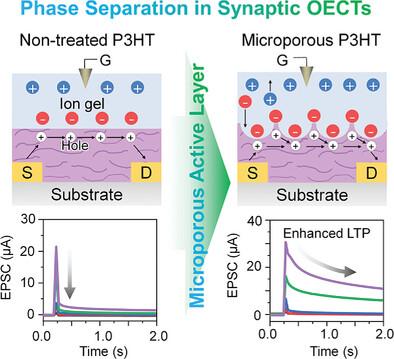Organic Electrochemical Transistors with Microporous Structures via Phase-Separation for Enhancing Long-Term Plasticity in Artificial Synapses
引用次数: 0
Abstract
Artificial synapses, inspired by the intricate design of biological synapses, utilize electrical, chemical, and mechanical signals to transmit and retain information. Recent advances have involved research on artificial synapses based on organic electrochemical transistors (OECTs), emphasizing low power consumption and rapid response times. A notable challenge arises when the gate voltage is removed, causing doped ions to return quickly to the electrolyte. A simple yet efficient approach is used to solve this problem: forming a microporous active layer using a phase separation method. This technique can maximize the contact area between the electrolyte and the active layer, enhancing ion doping/de-doping in OECTs. Improvements in the product of hole mobility and volumetric capacitance is achieved. The electrostatic coupling effect and electrochemical doping in synaptic OECTs occur better than in the pristine active layer, yielding enhanced performance with higher short-term and long-term synaptic plasticity, compared to pristine OECTs. Moreover, improved ambipolar characteristics is shown by n-dopant injection. This paper reports a way to improve performance by simply modifying the surface shape of the active layer using the phase separation, contributing to advancements in artificial synapses for neural networks.

通过相分离技术实现具有微孔结构的有机电化学晶体管,增强人工突触的长期可塑性
人工突触受到生物突触复杂设计的启发,利用电子、化学和机械信号来传输和保留信息。最近的进展涉及基于有机电化学晶体管(OECTs)的人工突触研究,强调低功耗和快速响应时间。当去除栅极电压时,掺杂离子会迅速返回电解质,这就带来了一个显著的挑战。为解决这一问题,我们采用了一种简单而高效的方法:利用相分离法形成微孔活性层。这种技术可以最大限度地扩大电解质与活性层之间的接触面积,从而增强 OECTs 中的离子掺杂/去掺杂效果。空穴迁移率和体积电容的乘积得到了改善。与原始 OECTs 相比,突触 OECTs 中的静电耦合效应和电化学掺杂效果优于原始活性层,从而增强了性能,提高了短期和长期突触可塑性。此外,注入正掺杂剂还能改善安培极特性。本文报告了一种利用相分离简单改变活性层表面形状就能提高性能的方法,有助于推动神经网络人工突触的发展。
本文章由计算机程序翻译,如有差异,请以英文原文为准。
求助全文
约1分钟内获得全文
求助全文

 求助内容:
求助内容: 应助结果提醒方式:
应助结果提醒方式:


